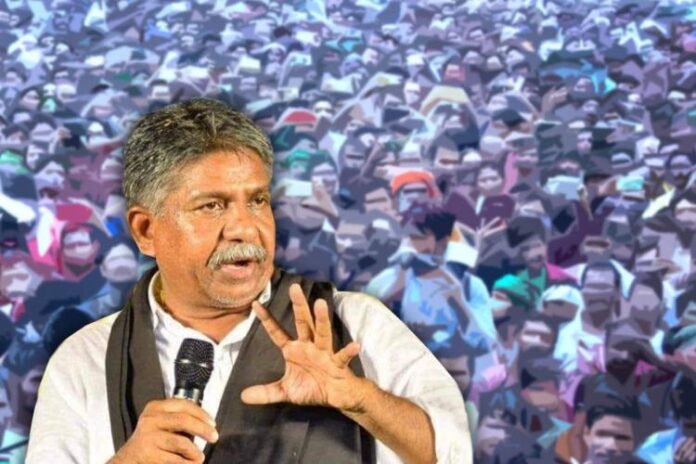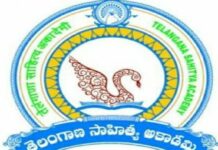A significant portion of the population in Andhra Pradesh, Telangana, Karnataka, and Tamil Nadu, where they are also known as Arudhathiyar, work as manual scavengers and leather workers.
Demonstrations by various opposition groups on the margins of Prime Minister Narendra Modi’s visit to Hyderabad last month for the Bharatiya Janata Party’s national executive conference generated quite a media spectacle. But the headlines that likely hurt the BJP were about the altercation that occurred between its party members and activists of the Madiga Reservation Porata Samithi, a Dalit group that it has been attempting to work with for years (MRPS). Images of BJP employees hitting MRPS activists after they attempted to block the entry to the PM’s event have surfaced. The relationship, which peaked in 2013 when MRPS leader Mandakrishna Madiga met with Modi while he was on the campaign trail for the 2014 elections, undoubtedly reached its lowest point at that time.
Following the meeting with Mandakrishna, the BJP promised in its 2014 election manifesto that it would amend the Constitution within 100 days and implement internal reservations within the Scheduled Caste (SC) category — the single-point demand of the MRPS. That promise has not yet been fulfilled, and the MRPS has made it clear that it intends to damage the prospects of the BJP in both Telangana and Andhra Pradesh, where Madigas form a significant chunk of the Dalit electorate. Historically occupied as manual scavengers and leather workers, Madigas are a sizeable population in Karnataka as well as in Tamil Nadu where they are also identified as Arudhathiyar.
Mandakrishna Madiga who was formerly known as Manda Eliya started in the early 1980s as a village-level anti-caste activist in the suburbs of Warangal. On one occasion, he led a series of vigilante-style attacks on a section dominant caste men who were exploiting and unleashing terror on the lowered castes. At this point, he found support from the dreaded People’s War Group (PWG), an armed Naxalite faction. However, he soon abandoned extremism for a lifetime of pragmatism to secure the rights of the most marginalised Dalit communities in the Telugu states through Constitutional means.
In the immediate years after his breakup with the Naxalites, Mandakrishna associated himself with the larger Dalit movement which started consolidating following the Kamarchedu (1985) and Tsunduru (1991) massacres. However, he soon got disillusioned as the Dalit movement, led by the Mala community, did not appreciate the cause of the Madigas and other smaller communities for rationalisation of the reservations.
These factors ultimately led to the formation of the MRPS in July 1994 in the village of Eedumudi in Prakasam district, under the leadership of Mandakrishna Madiga, Krupakar Madiga, Dandu Veeraiah Madiga, Visharadhan Maharaj and Mary Madiga and few others.
The term ‘Madiga’ was used as a slur until Mandakrishna and the other leaders added it as their surname to mark their assertion. The MRPS also made ‘dandora’ — the act of heralding people using the dappu or artisanal leather drum — a symbol of the movement seeking sub-classification of reservations. To many in the hinterland, the MRPS is known simply as Madiga Dandora.
The MRPS and its agenda of internal reservations spread like wildfire across undivided Andhra, uniting the Madiga community, which was numerically powerful but economically and socially backward compared to the other SC communities such as Mala and Adi-Andhra. Within a few years of its formation, the MRPS also came to represent the aspirations of communities which were even more marginalised than the Madigas in the fields of education and employment. Often called ‘satellite castes’ because of their cultural similarities with the Madigas, communities such as Dakkali, Chindu, Nulaka Chandrayyalu, Gosangi, Baindla, Mehatar, Budagajangam and Masti have rallied behind the MRPS over the years to form a powerful coalition of the lowest castes in Telugu society. These communities also stand to assert their autonomous identity both socially and politically in case sub-classification is introduced.
According to Professor Adapa Sathyanarayana, the string of changes in political, education, employment and administrative systems in the aftermath of the formation of Andhra Pradesh in 1956 paved the way for the Dandora movement. “The post-independence years saw the presence of Malas, particularly from the coastal regions, grow dramatically in legislative bodies and lower rung government jobs. Even as atrocities on Dalits as a whole by upper-castes increased during the 1970s and 80s, so did the gap between the Mala and Madiga. The Dalit Mahasabha, which was formed to respond to the Karamchedu and Tsunduru massacres, was the last time there was a united Dalit movement. The Dalit Mahasabha soon saw the desertion of Madiga leaders and this ultimately led to the formation of the MRPS or Madiga Dandora,” he says in his book 100 years of Dalit History in Andhra Pradesh.
Although the MRPS might be unknown outside the Telugu states, the demand for sub-classification within the SC category has a national resonance. It goes back to the advent of the policy of affirmative action in post-independence India which created a nationwide conflict at two levels.
On one hand, it led to hostility towards the lowered castes from the ruling castes. At the same time, it also sparked conflict between the different Dalit communities that were grouped under the Scheduled Caste (SC) category. It became clear that although all Dalits were socially and educationally backward, some Dalit communities were more advanced than others and in a better position to avail themselves ofgovernment schemes.
Mobilising the weaker Dalit communities has been a key strategy of the BJP, and has paid rich dividends in several elections starting with the win in 2014. In the 2018 elections in Karnataka, for instance, Madigas are said to have deserted the Congress owing to the fact that it was seen favouring the Holeyas under its rule. An observation suggested that BJP could have benefitted from Madiga votes in Karnataka. As part of this outreach, Rashtriya Swayamsevak Sangh’s (RSS) chief Mohan Bhagwat and BJP leader Amit Shah also visited Shiva Sharana Madara Chennaiah Mutt in Chitradurga district in Karnataka whose seer, Madara Channaaiah Sree, is a Madiga.
R Bhanuprakash, a member of the Bengaluru-based Dr BR Ambedkar Study Centre, says, “Though the division among the Dalits in Karnataka is not as sharp as it is in Andhra and Telangana, it is evident that the BJP is benefiting from the disparities among Dalits. By promoting certain Madiga faces, it is trying to appeal to the Madiga caste at the micro level. This is being projected as their method of inclusive politics.”
In Uttar Pradesh’s context, the BJP has mobilised the Pasi and Valmiki castes, which are more marginalised than other Dalit castes like Jatav and Chamar — the backbone of Mayawati’s Bahujan Samaj Party (BSP). The saffron party has also employed tactful appropriation of lowered caste icons such as the 11th century Pasi king Suheldev to amass the support of extremely marginalised Dalits.
In the Telugu states, the BJP’s leadership has worked assiduously to build a base among the socially and economically weaker of the two Dalit communities: the Madiga and its satellite castes. BJP leaders Kishan Reddy and Venkaiah Naidu have been vocal supporters of the MRPS demand for internal reservations since the early days of their political careers. Importantly, Naidu and Reddy have also cultivated the image of having a deep personal friendship with Mandakrishna Madiga.
Dr Gurram Seetharamulu, an independent scholar and writer, points out that the MRPS’s strategy has “always been shrewd” owing to the fact that it has had to represent a community which has been traditionally upstaged in the political arena by Mala-led lobbies. Dr Gurram says that ‘political reciprocity’ has been a key strategy of the MRPS since its inception. “Being a social movement with a specific goal, they have reached out to Congress, Telugu Desam Party (TDP) and Left parties, including the so called Naxalite parties. Now, for over eight years, they’ve been negotiating with the BJP as they are in power,” he says.
In the early 2000s, the MRPS put its weight behind the Telugu Desam Party (TDP) after the then Chief Minister Nara Chandrababu Naidu passed the ‘Rationalisation of Reservation Act’ to categorise SCs into A, B, C and D groups in accordance with each group’s relative backwardness and proportion of population. This was on the basis of the recommendations of the Justice Ramachandra Raju Commission appointed by the TDP government in 1996. The state government’s legislation was struck down by the Supreme Court in less than four years on the grounds that the state did not have the authority to rework the Presidential List of Scheduled Castes.
Subsequently, the Congress government of YS Rajasekhar Reddy also passed a resolution in favour of categorisation. Reddy’s government also pushed the Congress-led United Progressive Alliance (UPA) government to appoint the Justice Usha Mehra Commission in 2007. Although the Mehra commission favoured the amendment of Article 341 of the Constitution to provide for sub-categorisation, the Manmohan Singh government dithered and ultimately failed to introduce a Bill in Parliament.
The UPA government’s betrayal cost the Congress dearly in the state. In 2009, one MRPS activist died in the inferno when the group set fire to the Congress headquarters in Hyderabad. At the time, it was largely believed that Madiga sympathies had shifted firmly in favour of Telangana Rashtra Samithi (TRS) supremo K Chandrasekhar Rao, who ultimately became the first Chief Minister of Telangana. The TRS government that took charge of the new state also passed a resolution supporting the classification, but the matter has been in a state of limbo with the Union government.
Interestingly, in the case of Tamil Nadu the Supreme Court has allowed 3% sub-quota to Arundathiyar community within the 18% Scheduled Caste (SC) reservation quota, owing to their historical backwardness, marginalisation.
Supporters of the MRPS say that there is nothing unusual about the MRPS lobbying with the BJP in pursuit of its demands which are unrelated to which party is in power. However, this bipartisan attitude of the MRPS has led critics to accuse it of being opportunistic and dividing the larger Dalit movement in the state. The organisation has often been accused of being a tool in the hands of whichever party is in power because of the fact that they can only negotiate for policy change with the government.
Krupakar Madiga, one of the founders of MRPS, says, “To achieve its democratic demand, the movement has reached out to all the parties. Those who did not like the idea of rationalisation of SC reservations have accused us of dividing the Dalit movement.”
Mandakrishna Madiga organised a mass meeting demanding internal reservations in 2016, at a time when the Rohith Vemula movement was at its peak. The death of Vemula, a Mala Dalit PhD scholar at the Hyderabad Central University (HCU) following alleged harassment from ABVP and BJP leaders, had triggered a nationwide Dalit agitation against the ruling party. The MRPS event at the time featured not just Venkaiah Naidu and Kishan Reddy but also Bandaru Dattatreya, who was listed as an accused in the death of Rohith Vemula.
With the recent fracas between BJP and MRPS workers, these ties appear strained. The MRPS’s options are also limited by the fact that its staunchest supporter, Venkaiah Naidu, is no longer in active politics. In 2016, Naidu had tried to bring all parties together to push for a Constitutional amendment.
The MRPS has come under criticism from certain Dalit activists and ‘progressive intellectuals’ for giving space to BJP leaders. However, Mandakrishna Madiga’s attempt to broker peace between HCU students who were agitating against suspensions just days before Rohith Vemula’s death, is not talked about much. His supporters say that BJP leaders’ presence at MRPS mass meetings has somehow erased the organisation’s contribution to the recent popular Dalit movement.
Gogu Shyamala, a prominent writer and scholar who also hails from the Madiga caste, says that the recent protest by the MRPS at BJP venues was an attempt to send out a message to BJP to remind them of their promise of classification. She points out that the outfit’s electoral significance is not just limited to Madigas. “Mere peripheral understanding can lead us to think that they’re with a specific party. Their movement is not just for the representation of Madigas it’s more about giving their due share to extremely vulnerable satellite castes like Baindla, Chindu, Gosangi, Mehatar, Budagajangam and dozens of others,” she says.
MRPS Telangana state president Govindu Naresh Madiga says, “We used each and every channel to convey our concerns to the ruling BJP, as it is upto the Parliament to pass a Bill by amending Article 341 or allowing the states to implement SC categorisation. But they too have ignored it and now we are marching against their anti-Madiga attitude.”
Govindu Naresh Madiga says, “We have declared the BJP as a political rival for Madigas and other vulnerable Dalit castes, as they have ignored their promise despite having a majority in the Parliament. In fact we are the only organisation which protested against the BJP and Modi in Hyderabad, not those who blame our movement.”
According to Gopani Chandraiah, Associate Professor in Political Science at Allahabad Central University, different political parties using the disparities among Dalits is not a new phenomenon in India. Gopani Chandraiah says, “There are certain Dalit castes which are visible and articulate as a result of relative educational and employment opportunities. There are other castes which are more vulnerable and disadvantaged as they have not got access to the same opportunities. All the political parties use such social disparities among Dalits to their advantage. In fact, the BJP is doing what the Congress has done earlier. But the danger with the BJP using it is that it injects Hindutva and false pride into people, and that can be a serious threat to what the larger Dalit movement envisages.”
Chandraiah cautions that the Dalit movement has to understand the internal disparities and introspect in order to strengthen and prevent it from hijack by forces which are against the very idea of Dalit emancipation. #KhabarLive #hyderabadlive #hydnews #hyderabadi







